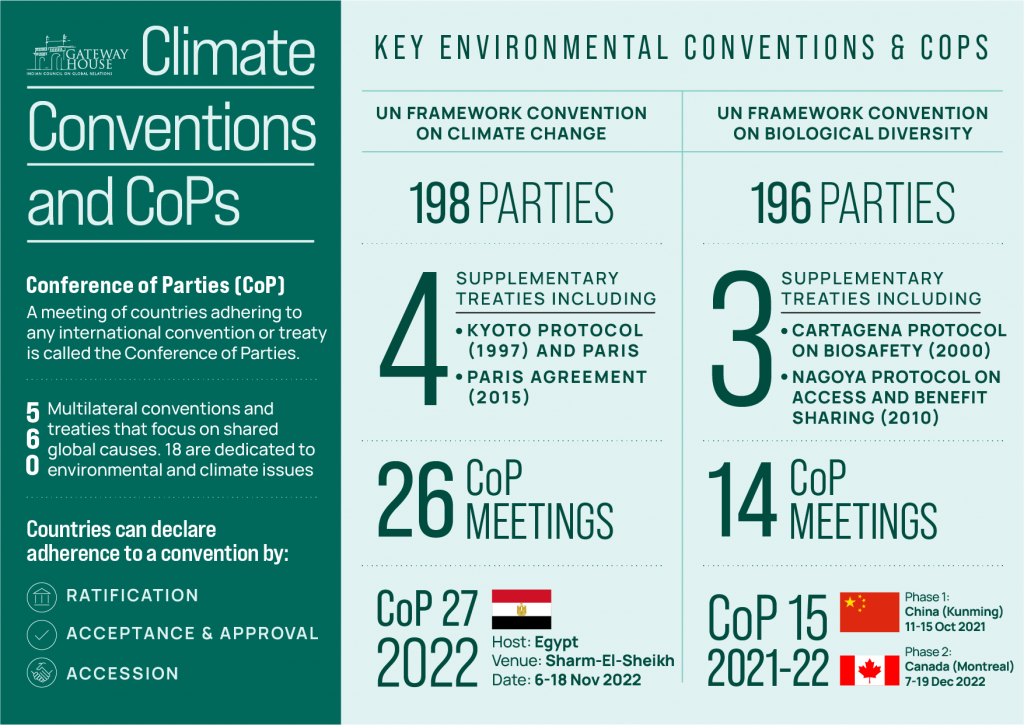On November 6, the Egyptian resort of Sharm El-Shaikh will be host to the COP27, the 27th Conference of the Parties of the UNFCCC (UN Framework Convention on Climate Change).
This infographic shows the two types of multilateral approaches and agreements that countries have signed on to under the umbrella of the United Nations. To solve the shared global challenge of climate change, with actions required beyond sovereign jurisdictions.
The document containing such principles for solving a shared concern, is called a ‘convention’ or ‘treaty’. There is also a ‘Conference of Parties.

Conventions:
There are 560 such international agreements deposited with the United Nations Secretary General dealing with a range of diverse issues from disarmament and human rights to outer space[1].
Of these, 18 conventions deal with environmental and climate-related challenges. These 18are further elaborated through several protocols, supplementary treaties and agreements developed under their guidance.
The United Nations Conference on Environment and Development, also known as the Earth Summit, held in 1992 was the landmark meeting on environmental challenges in which two important international conventions were agreed upon: the United Nations Framework Convention on Climate Change (UNFCCC) and the Convention on Biological Diversity (CBD). Other important international conventions pertaining to environmental issues include the Vienna Convention on Protection of the Ozone layer, agreed in 1985 and the United Nations Convention to Combat Desertification (1994), among others.
Depending upon the structure of a convention or treaty, a signatory country may use either of the follow three approaches to declare that it is bound by the convention – ratification, acceptance and approval, as well as accession[2].
- ‘Ratification’ means the country’s sovereign body- such as the Parliament, or the Cabinet or The Office of the President etc. – declare that it is bound by the convention.
- ’Acceptance and approval’ are also used similarly as ratification because there are no other country-level formalities required to be bound by the given treaty.
- ‘Accession’ is when a country decides to join a treaty that is already agreed or negotiated by other countries.
Conventions normally require certain thresholds to be reached before they enter into force such as number of countries signing it, or the number of parties emitting certain quantum of pollutants to accept or ratify the convention.
Conference of Parties (CoP):
Countries joining the convention are called ‘Parties’ to the convention. They meet regularly to discuss and review the status of implementation of the convention and related matters. These meetings are referred to as as ‘Conference of Parties’ or CoP.
The frequency of these meetings vary. A CoP of the UNFCCC takes place annually, while that of the Convention on Biological Diversity of (CBD) occurs biannually. Parties may also develop actionable targets and programmes to achieve the objectives of the convention. Such documents may be called as the Protocols or Agreements, prominent examples being the Kyoto Protocol (1997) and the Paris agreement (2015) under the UNFCCC or the ‘Nagoya Access to Genetic Resources and the Fair and Equitable Sharing of Benefits Arising from their Utilization’ (2010) and Cartagena Protocol on Biosafety (2000), under the CBD.
Damodar Pujari is Fellow, Climate Change at Gateway House.
Infographic Designed by Debarpan Das.
This infographic was exclusively developed for Gateway House: Indian Council on Global Relations. You can read more exclusive content here.
For permission to republish, please contact outreach@gatewayhouse.in
© Copyright 2022 Gateway House: Indian Council on Global Relations. All rights reserved. Any unauthorised copying or reproduction is strictly prohibited.
[1] https://treaties.un.org/pages/participationstatus.aspx?clang=_en
[2] https://treaties.un.org/pages/overview.aspx?path=overview/glossary/page1_en.xml#accession